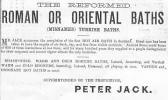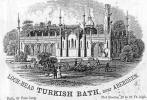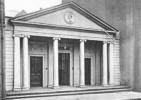3. Roman bath or Turkish bath?

If today the term Irish-Roman bath seems a more accurate description, most Victorian proprietors contented themselves with advertising their baths as Turkish.

Some tried to have their cake and eat it by using the phrase Roman or Oriental Baths.

While others—especially in Ireland—called them ‘Improved’ Turkish Baths. The use of ‘Improved’ in this context is not, as was once suggested to me, a Saidian example of how the west appropriated an oriental institution while still emphasising its own superiority.

More prosaically, it came from an application which Barter made in 1859, for a patent entitled ‘Improvements in heating and ventilating buildings, and in apparatus connected therewith’5 which he indicated was particularly relevant in ‘the heating of the improved Turkish or Roman bath’ constructed by him at St Ann’s.
All patent applications are necessarily for a new invention, or for an improvement on an existing one. Barter’s improvement recirculated the heated air from the hot rooms, passing it over the furnace, and into the hypocaust, thereby considerably cutting his fuel costs.
The improvement was on the Roman hypocaust, not the Turkish institution.
The Victorians discussed, in a variety of journals6 and elsewhere, whether the bath should be called Roman or Turkish. A reading today of selected contributions to that discussion has led to the suggestion that in preferring the term Roman bath the west was reclaiming its ancestry from the east. Or, that Roman (read European) baths would be more acceptable to a British public than Turkish (read oriental) baths.7
Although there were some writers (particularly amongst the opponents of the bath who were often doctors feeling threatened by it) who argued that a great empire could not adopt the bath of the ‘indolent, languid, luxurious Turk’,8 such ideas were far from the minds of those who reintroduced it.
To Barter, ‘Roman’ only implied dry air, as opposed to ‘Turkish’ which implied vapour.
Urquhart’s use of the term Turkish bath, though he well knew its Roman origins, was quite deliberate. He additionally saw the bath as an effective means of introducing Turkish culture to the British people, not as a curiosity to amuse them, but as something worthy of emulation. Indeed, Dr Avcıoğlu has perceptively argued that Urquhart’s criticism of earlier travellers’ descriptions of the hammam could almost have been written by Edward Said.9
Terminology also impinged on discussions about the architectural style to be used for Turkish baths, especially around 1861, by which time over three dozen establishments had already opened. Architects asked whether they have to look Turkish, or perhaps even Roman.
In a lecture at the Liverpool Architectural Society,10 W H Hay described the Turkish bath he had just designed for the very middle class Lochhead Hydropathic Establishment near Aberdeen.

His brief was ‘to produce a certain accommodation at the very smallest outlay’ and his plan was ‘based upon the baths of ancient Rome’.
I have adopted the Turkish or oriental style of architecture with a touch of Eastern grandeur, so that the Turkish Baths might not be altogether a misnomer to the uninitiated; nevertheless, there is a very large demand made upon the practical skill and experience of an architect in the erection of works of this kind. But I was employed to design Turkish baths, and Turkish baths they must be; to arrange the interior as I pleased; but the bulbous domes and gilded minarets must appear in all the cheapest and most showy style, so that the Oriental character might be realised as freshly as from a perusal of Lalla Rookh.
I should be inclined, however, to recommend a thoroughly English style of architecture as decidedly preferable to this.11
In complete contrast, in Jesus Lane, Cambridge, we can still see Matthew Digby Wyatt’s classical portico fronting the grand Roman baths built for the newly incorporated Roman Bath Company which opened in February 1863.

The Roman emphasis was deliberate: intended to indicate clearly that this was to be no steamy hammam. But it was not a success, and closed before the end of the year.…
